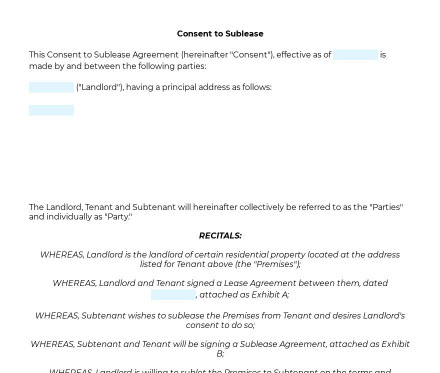Consent to Sublease Free
A landlord who is giving formal consent to a tenant to sublease the property can use A Consent to Sublease.


 Template Overview
Template Overview
A landlord who is giving formal consent to a tenant to sublease the property can use A Consent to Sublease. The subtenant or the individual that will be taking over the lease responsibilities from the tenant is called the third party. A Consent to Sublease is usually a simple and clear document outlining the specifics between all parties. The paper is quite simple as it is accompanied by the original Lease Agreement and the new Sublease Agreement.
In situations where it is not explicitly stated that the tenant may sublease, a Consent to Sublease agreements should be used. A common legal requirement is the written consent of the landlord.
This Consent to Sublease should only be used when the original lease is for residential use and not for the commercial one.
You fill out a form. The document is created before your eyes as you respond to the questions.
At the end, you receive it in Word and PDF formats. You can modify it and reuse it.
 How to use this template
How to use this template
This document is used when the tenant has a specific subtenant willing to take over the lease, and there has already been a verbal conversation with the landlord. Specifically, use this document once you have agreed on all the terms.
Provide contact information (name, address, etc.) for all parties in the document. Then answer a few questions about the subtenancy terms (rent and deposit information).
Once completed, we recommend to print it so that a copy of the Lease Agreement can be attached as an Exhibit A, and a copy of the Sublease Agreement can be attached as Exhibit B. Make sure to keep signed copies by all three parties.
 Applicable law
Applicable law
In the US, state-specific laws are covering residential leases and agreements related to them. In other words, this Consent to Sublease will be governed by the law of the specific state where the property is located.
Ready to build your document from this template?



 Please wait
Please wait